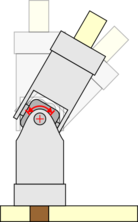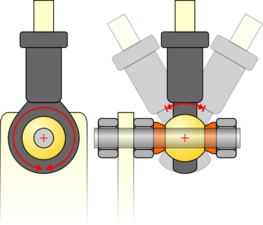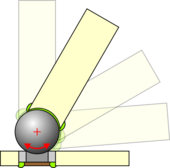Joints for Delta Printer
Contents
Principle and Requirements
TBD
The precision of nozzle positioning depends on rod length and a correct nodal point.
Variants
Cardan Joint
TBD
DIY Cardan Joint
TBD
PROs:
- Very low cost
- TBD
CONs:
- Precision depends on manufacturing and assembling. Little manufacturing and assembling error results in a much bigger nozzle positioning error
- Needs more space in construction
- TBD
Industrial Cardan Joint
TBD
Main Problem: In only 4 directions the joint can be tilt up to 90°. In directions between the usable angle is limited to about 30° (depends on design).
PROs:
- Ready to use
- M4 or M5 mounting threads
- Less friction
- Threaded rods can be used in between
CONs:
- Cost per joint about 12 Euro
- Have to be constructed in 45° angle to minimize limits
- Have to be mounted in optimal working direction
Rod End Bearing
TBD
Main Problem: At rotation axis the joint is designed for endless rotation. But at the tilt axis the joint is limited by construction. As manufacturer documentation tilt is limited to ±30° (Source: igus.de). To use the maximum reaching area as printing area a tilt angle of 35…40° is necessary. In result you can use only a limited printing area.
PROs:
- Ready to use components
- Threaded rods can be used in between
CONs:
- Limited printing area
- Conical spacer required
- TBD
Magnetic Joint
- main article: magnet joint
TBD
Note: V2A balls are not magnetic and can not be used!
PROs:
- Precision by design
- No backlash
- Implicit correct and well known nodal point
- Low cost. About 1 Euro per joint
- Simple construction
- Easy assembly
- Easy disconnecting for service and transport
CONs:
- Limited holding force
- Magnets are sensitive to shock and high temperatures
Magnet in Tube Variant
TBD
PROs (additional):
- TBD
CONs (additional):
- Precision depends on tube cutting and deflashing
- TBD
Moving Ring Magnet Variant
The bearing balls are glued to the lift and carriage. The ring magnets are part of the rods.
TBD
PROs (additional):
- TBD
CONs (additional):
- TBD
Fixed Ring Magnet Variant
The ring magnets are pressed in and glued to the lift and carriage. The bearing balls are part of the rods.
TBD
PROs (additional):
- Depending on design up to (and over) ±90° tilt angle
CONs (additional):
- TBD





